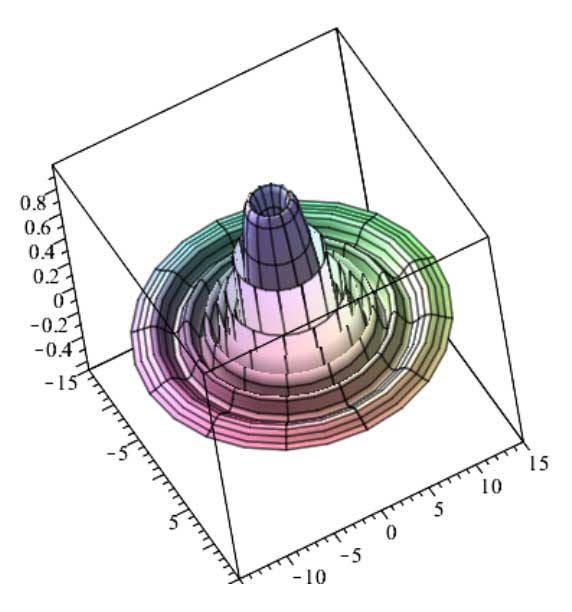When Jordan Spieth failed to make the green on the 12th at Augusta in 2016 and saw his ball plunge into the lake, his dismay was perhaps tempered by the beautifully symmetric ripples or waves emanating from the point where the ball entered the water. An example of such a splash can be seen in Figure 1.

This is a classical free surface fluid mechanics problem involving the Navier–Stokes equations together with the conservation of mass. These may be solved by a variety of methods. We choose a finite difference method employing marker and cell (MAC method) on a staggered grid, which we have been developing over many years. A review of the MAC method may be found in [1]. Figure 2 displays the numerical solution of a splashing drop at three different times using the MAC method (albeit, in a confined region with wave reflection). Note that in Figure 1, a series of concentric crests and troughs are observed whose amplitudes are not constant, nor are the distances between the crests.

It is, however, well known but nonetheless somewhat surprising that substantial progress may be made analytically using asymptotic arguments. In the remainder of this note we shall show how using Hankel transforms, the method of stationary phase and asymptotic analysis, can lead to a simple analytic expression which encapsulates the main features of the flow and indeed compares tolerably with the computation of Figure 2.
An asymptotic expression
In cylindrical polar coordinates with -axis vertically upwards, the linearised water wave equations are
 where
where denotes the elevation (above
) of the water and
is the velocity potential (i.e.
). See, e.g. Coulson [2].
Note that from Jordan Spieth’s point of view, time is initiated, not when his ball hits the water, but at the time when the resultant splash occurs.
Define the Hankel transforms
Taking Hankel transforms of (1) yields
or, using (4),
(6)
Equations (2) and (3) provide
(7)
whence
and so
Substituting back into (6) then gives
However,
and so
Moreover, substitution into the Hankel transform of (2) results in
(8)
However,
when and so
Thus, from (8), we have
Taking the inverse Hankel transform results in
where
Let us define the initial disturbance to be
(9)
at time .
Then
Therefore
(10)
The integral form of the Bessel function is
We may therefore express (10) as follows:
(11)
where denotes the real part of the double integral.
Interchange the order of integration and define
(12)
With the change of variables and
, then (12) becomes
(13)
Here we assume . In this case, the trigonometric functions will vary extremely rapidly from
to
with the positive and negative components cancelling each other out. This will happen except where the function
is stationary in the interval of integration. We observe that this will not be the case for
since the stationary point is outside the range of integration. Thus the leading order term in (13) is the second (and consequently the first may be neglected). Furthermore
implying that the stationary point is
Excluding in the neighbourhood of
, we may write
Then the integral (13) may be approximated by
with the integral outside the range cancelling to zero.
The factors and
are slowly varying compared with the rapidly fluctuating cosine and sine functions and so may be replaced by
and
, respectively.
Thus
We now make the following further change of variables:
so that
The limits in the integral can be considered infinite if , implying
for a small, but fixed
assuming
(that is, excluding
in the neighbourhood of
).
Now
(14)
so that we may write
Furthermore,
so when
and consequently
and we can write
(15)
Substituting back into equation (11) results in
(16)
On introducing the volume displaced by the initial pulse , equation (16) becomes
(17)
We shall consider such that
remains finite (and constant). Introducing a final change of variables
, (17) becomes
(18)
We now consider the asymptotic limit as , i.e.
, or
.
Once again we note that for large (and
) the integrand oscillates extremely rapidly and so defining
we observe that implies
. Further
and so
We may therefore replace (18) by
and, since the integral is essentially annihilated (cancels itself out) for we may write
Note that for
and is slowly varying for
.
Thus
since
Thus, upon taking the real part, we obtain
(19)
where, recall, .

The asymptotic expression (19) for the resulting concentric waves are displayed in Figure 3. It should be stressed that this is only a valid approximation when the fluid velocity is small (i.e. can be neglected) and when
and
.
We note that becomes infinite at
(a direct result of letting
for a fixed
); however, in Figure 3, a smoothing function has been added for exposition. The amplitudes of the crests decrease according to
or
. Furthermore, it is easily seen that the crests follow each other at a distance
Hence the wavelength is no longer a constant, but increases at constant
with
and decreases at constant
with
.
For further reading on the subject and more complicated wave patterns, for example, the wake behind a ship, the reader is referred to [4] and [5].
Sean McKee CMath FIMA
University of Strathclyde
Murilo F. Tomé
University of São Paulo
References
- McKee, S., Tomé, M.F., Ferreira, V.G., Cuminato, J.A., Castelo, A. and Sousa, F.S. (2008) The MAC method, Comput. Fluids, vol. 37, pp. 907–930.
- Coulson, C.A. (1961) Waves, Oliver and Boyd, Edinburgh.
- Spiegel, M.R. (1964) Theory and Problems of Complex Variables, Schaum Publishing Co, NY.
- Whitham, G.B. (1999) Linear and Nonlinear Waves, Wiley, New Jersey.
- Johnson, R.S. (1997) A Modern Introduction to the Mathematical Theory of Water Waves, Cambridge University Press.
Reproduced from Mathematics Today, April 2018
Download the article, Ripples from a Splashing Drop (pdf)
Image credit: Water Drop. Crown, close. © Evan Spiler | Dreamstime.com



